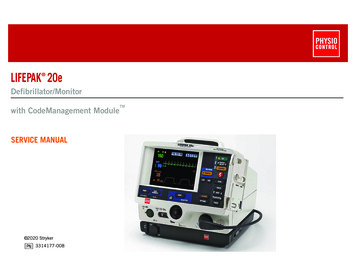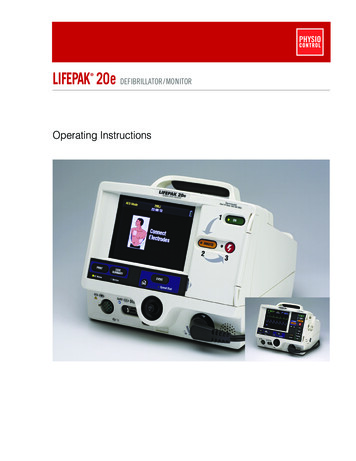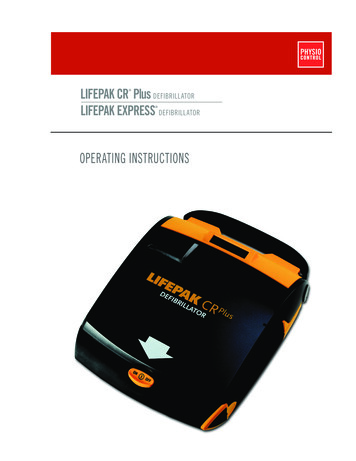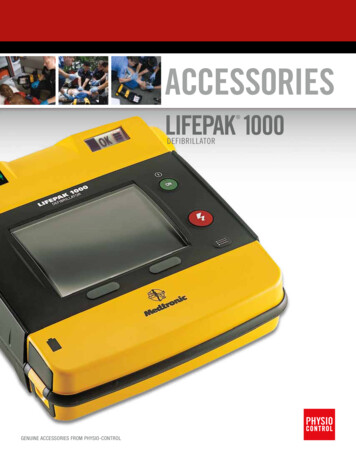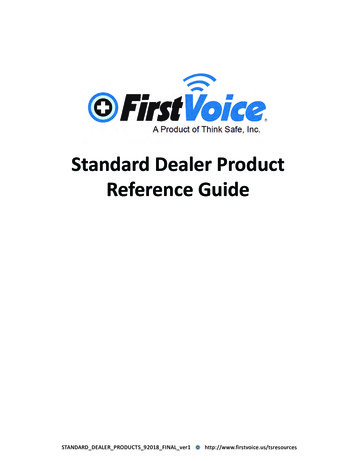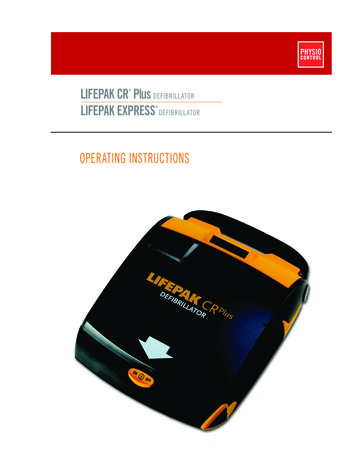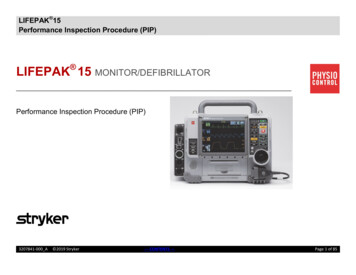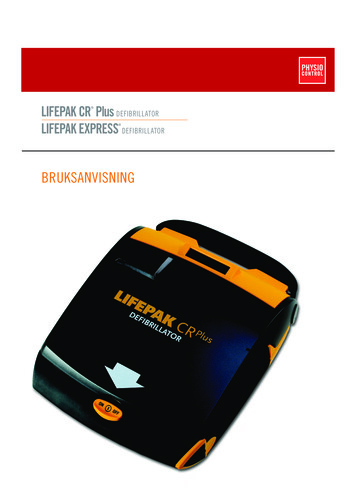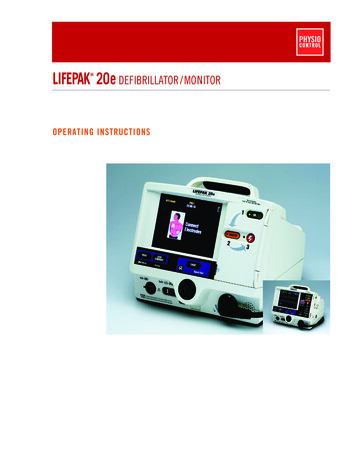
Transcription
LIFEPAK 20e DEFIBRILLATOR /MONITOR OPERATING INSTRUCTIONS
LIFEPAK 20e DEFIBRILLATOR /MONITOR OPERATING INSTRUCTIONS
Important Information!USA Rx Only!USADevice TrackingThe U.S. Food and Drug Administration requires defibrillator manufacturers and distributors to track thelocation of their defibrillators. If the device is located somewhere other than the shipping address or thedevice has been sold, donated, lost, stolen, exported, destroyed, permanently retired from use, or if thedevice was not obtained directly from Physio-Control, please do one of the following: register the device athttp://www.physio-control.com, call the device tracking coordinator at 1.800.426.4448, or use one of thepostage-paid address change cards located in the back of this manual to update this vital trackinginformation.Text ConventionsThroughout these operating instructions, special text characters are used to indicate labels, screenmessages, and voice prompts: Operating control labels: CAPITAL LETTERS such as ON/OFF and SHOCK. Screen messages and voice prompts: CAPITAL ITALICIZED LETTERS such as CONNECT ELECTRODES.Version HistoryThese operating instructions describe LIFEPAK 20e defibrillator/monitor devices with software version3202609-058 or later.LIFEPAK, FAST-PATCH, DERMA JEL, QUIK-LOOK, and QUIK-COMBO are registered trademarks of Physio-Control, Inc. ADAPTIV, CODE-STAT,CODE SUMMARY, REDI-PAK, and Shock Advisory System are trademarks of Physio-Control, Inc. Masimo and LNOP are registered trademarks ofMasimo Corporation. EDGE System is a trademark of Ludlow Technical Products. STERRAD is a registered trademark of Advanced SterilizationProducts. SPUNGUARD is a registered trademark of Kimberly-Clark Worldwide, Inc. Microsoft and Windows are registered trademarks of MicrosoftCorporation. Specifications are subject to change without notice. 2006-2008 Physio-Control, Inc. All rights reserved.Publication Date: 10/2008MIN 3205878-007
TABLE OF CONTENTSPrefaceAbout Automated External Defibrillation .viiiAbout Defibrillation Therapy .viiiAbout Noninvasive Pacing .ixAbout SpO2 Monitoring .ixAbout ECG Monitoring . x1 Safety InformationTerms .1-2General Warnings and Cautions.1-2Symbols.1-32 Basic OrientationIntroduction .2-2Unpacking and Inspecting .2-2Controls, Indicators, and Connectors .2-3Area 3 .2-6Area 4 .2-7Area 6 .2-9Changing Printer Paper .2-10Back View. 2-11Entering Patient Data. 2-12Setting Alarms . 2-13Managing Alarms . 2-15Connecting to Power . 2-16AC Operation . 2-16Battery Operation . 2-16Battery Performance and Life. 2-16Battery Status Indicator. 2-17LIFEPAK 20e Defibrillator/Monitor Operating Instruction 2006-2008 Physio-Control, Inc.iii
3 MonitoringMonitoring the ECG.3-2ECG Monitoring Warning.3-2Selecting ECG Lead and Size .3-2Adjusting the Systole Tone Volume . 3-3Monitoring with the Patient ECG Cable.3-5Troubleshooting Tips for ECG Monitoring.3-7Monitoring SpO2.3-9SpO2 Warnings and Cautions.3-9When to Use a Pulse Oximeter . 3-10How a Pulse Oximeter Works . 3-10SpO2 Monitoring Considerations. 3-11SpO2 Monitoring Procedure. 3-12SpO2 Waveform . 3-12SpO2 Volume. 3-12Sensitivity. 3-12Averaging Time . 3-13Pulse Oximeter Sensors . 3-13Compatibility with Nellcor Sensors . 3-13No Implied License. 3-13Cleaning . 3-13Troubleshooting Tips for SpO2 . 3-144 TherapyGeneral Therapy Warnings and Cautions. 4-2Therapy Electrode and Standard Paddle Placement .4-3Anterior-lateral Placement.4-3Anterior-posterior Placement .4-3Special Placement Situations . 4-4Automated External Defibrillation . 4-4AED Warnings.4-5AED Setup.4-5AED Procedure.4-6Special AED Setup Options.4-10Troubleshooting Tips for AED Mode . 4-13Switching from AED to Manual Mode . 4-13Manual Defibrillation .4-14Manual Defibrillation Warnings .4-14Impedance . 4-15Defibrillation Procedure.4-16Synchronized Cardioversion Procedure .4-16Remote Synchronization Procedure.4-18Pediatric Defibrillation.4-19Pediatric Paddle Placement .4-19Defibrillation Procedure.4-20Troubleshooting Tips for Defibrillation and Synchronized Cardioversion.4-20Noninvasive Pacing.4-22Noninvasive Pacing Warnings.4-22Demand and Nondemand Pacing.4-22Noninvasive Pacing Procedure. 4-23Troubleshooting Tips for Noninvasive Pacing.4-24ivLIFEPAK 20e Defibrillator/Monitor Operating Instructions
5 Paddle Accessory OptionsTherapy Electrodes.5-2About Therapy Electrodes .5-2Electrode Placement . 5-3Cable Connection.5-4ECG Monitoring and Therapy Procedures.5-4Replacing and Removing Electrodes . 5-5Testing . 5-6Cleaning and Sterilizing. 5-6Standard Paddle Set (Optional) . 5-6About the Standard Paddle Set . 5-6Accessing the Pediatric Paddles . 5-7Replacing the Adult Paddle Attachment. 5-7External Sterilizable Paddles (MIN 3009166) .5-8About External Sterilizable Paddles.5-8ECG Monitoring and Therapy Procedures. 5-8Cleaning and Sterilizing. 5-8Internal Handles with Discharge Control (MIN 3010901) .5-9About Internal Handles with Discharge Control . 5-9Inserting the Paddles. 5-10Removing the Paddles. 5-10Internal Defibrillation Procedure. 5-10Internal Paddles Synchronized Cardioversion Procedure . 5-11Handling Internal Paddles . 5-11Cleaning and Sterilizing. 5-11Testing . 5-11Cleaning and Sterilization Guidelines . 5-12Cleaning . 5-12STERRAD Hydrogen Peroxide Gas Plasma Sterilization.5-136 Data ManagementOverview of Data Storage and Retrieval .6-2Data Storage .6-2Report Types.6-2Memory Capacity.6-2CODE SUMMARY Report .6-2Preamble . 6-3Event/Vital Signs Log. 6-3Waveform Events.6-4CODE SUMMARY Format. 6-5Managing Archived Patient Records.6-6Entering Archives Mode.6-7Printing Archived Patient Reports .6-7Editing Archived Patient Records.6-8Deleting Archived Patient Records .6-9Overview of Connections for Transmitting Reports. 6-107 Maintaining the EquipmentGeneral Maintenance and Testing .7-2Maintenance and Testing Schedule.7-2Daily Auto Test . 7-3User Test.7-4Cleaning . 7-5LIFEPAK 20e Defibrillator/Monitor Operating Instructions 2006-2008 Physio-Control, Inc.v
Function Checks .7-5Patient ECG Cable Check.7-5General Troubleshooting Tips .7-10Service and Repair . 7-12Product Recycling Information . 7-12Recycling Assistance . 7-12Preparation. 7-12Recycling of Disposable Electrodes . 7-12Packaging . 7-12Warranty . 7-12Accessories, Supplies, and Training Tools . 7-138 Defining Setup OptionsSetup Options .8-2Print Configurations Before Service or Repair .8-2Passcode Security.8-2Entering Setup Options .8-3General Setup Menu .8-4Manual Mode Setup Menu .8-5AED Mode Setup Menu.8-7Pacing Setup Menu.8-8Monitoring Menu .8-9Channels Setup Menu.8-9Waveform Sets Setup Menu .8-9Events Setup Menu .8-10Alarms Setup Menu.8-10Printer Setup Menu .8-11Auto Print Setup Menu .8-11Clock Setup Menu.8-12Reset Defaults Setup Menu .8-12Print Defaults.8-12Send Configuration Setup Menu .8-12Set Passcode Setup Menu. 8-13Service Mode . 8-13A Specifications and Performance CharacteristicsB Clinical SummariesC Screen MessagesD Operator’s ChecklistE Shock Advisory SystemF About cprMAX TechnologyG Docking StationH Declaration of Conformity/Electromagnetic Compatibility GuidanceIndexviLIFEPAK 20e Defibrillator/Monitor Operating Instructions
PrefacePREFACEAbout Automated External DefibrillationAbout Defibrillation TherapyAbout Noninvasive PacingAbout SpO2 MonitoringAbout ECG MonitoringLIFEPAK 20e Defibrillator/Monitor Operating Instructions 2006-2008 Physio-Control, Inc.page viiiviiiixixxvii
PrefaceABOUT AUTOMATED EXTERNAL DEFIBRILLATIONThe following considerations and guidelines apply when using the LIFEPAK 20e defibrillator/monitor asan automated external defibrillator (AED).Operator ConsiderationsThe LIFEPAK 20e defibrillator/monitor, when in AED mode, is a semiautomatic defibrillator that uses apatented Shock Advisory System . This software algorithm analyzes the patient’s electrocardiographic(ECG) rhythm and indicates whether or not it detects a shockable rhythm. The LIFEPAK 20edefibrillator/monitor in AED mode requires operator interaction to defibrillate the patient.The LIFEPAK 20e defibrillator/monitor in AED mode is intended for use by personnel who are authorizedby a physician/medical director and have, at a minimum, the following skills and training: CPR training. AED training equivalent to that recommended by the American Heart Association. Training in the use of the LIFEPAK 20e defibrillator/monitor in AED mode.IndicationsThe AED mode is to be used only on patients in cardiopulmonary arrest. The patient must beunconscious, pulseless, and not breathing normally before using the defibrillator to analyze the patient’sECG rhythm.In AED mode, the LIFEPAK 20e defibrillator/monitor is not intended for use on pediatric patients lessthan 8 years old.ContraindicationsNone Known.ABOUT DEFIBRILLATION THERAPYOperator ConsiderationsA direct current defibrillator applies a brief, intense pulse of electricity to the heart muscle. TheLIFEPAK 20e defibrillator/monitor delivers this energy through disposable electrodes, standard paddlesor internal paddles applied to the patient’s chest.Defibrillation is only one aspect of the medical care required to resuscitate a patient with a shockableECG rhythm. Depending on the situation, other supportive measures may include: Cardiopulmonary resuscitation (CPR) Administration of supplemental oxygen Drug therapySuccessful resuscitation is related to the length of time between the onset of a heart rhythm that doesnot circulate blood (ventricular fibrillation, pulseless ventricular tachycardia) and defibrillation. TheAmerican Heart Association has identified the following as critical links in the chain of survival fromcardiac arrest: viiiEarly accessEarly CPR by first responders or bystandersEarly defibrillationEarly advanced life supportLIFEPAK 20e Defibrillator/Monitor Operating Instructions
PrefaceIndicationsDefibrillation is a recognized means of terminating certain potentially fatal arrhythmias, such asventricular fibrillation and symptomatic ventricular tachycardia. Delivery of this energy in thesynchronized mode is a method for treating atrial fibrillation, atrial flutter, paroxysmal supraventriculartachycardia and, in relatively stable patients, ventricular tachycardia.The biphasic defibrillation waveform used in this defibrillator has only been clinically tested on adults; ithas not been tested on pediatric patients.ContraindicationsDefibrillation is contraindicated in the treatment of Pulseless Electrical Activity (PEA) such asidioventricular or ventricular escape rhythms, and in the treatment of asystole.ABOUT NONINVASIVE PACINGA noninvasive pacemaker is a device that delivers an electrical stimulus to the heart, causing cardiacdepolarization and myocardial contraction. The energy is delivered through large adhesive electrodesplaced on the chest. In addition to noninvasive pacing, other supportive measures may be necessary.Among other factors, it is recognized that successful pacing of a patient is related to the length of timebetween the onset of a dysrhythmia and the initiation of pacing. Rapid pacing and prompt follow-upcare are essential. The phys
The following considerations and guidelines apply when using the LIFEPAK 20e defibrillator/monitor as an automated external defibrillator (AED). Operator Considerations The LIFEPAK 20e defibrillator/monitor, when in AED mode, is a semiautomatic defibrillator that uses a patented Shock Advisory System . This software algorithm analyzes the .
